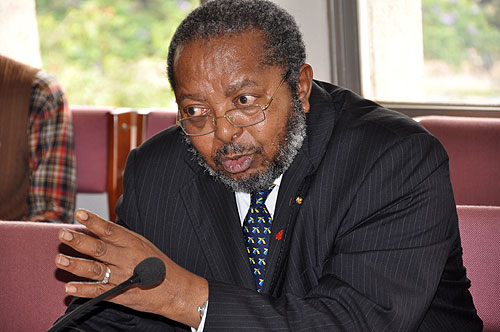The Bank of Uganda has kept its key lending rate at 9.0 per cent in August, and its governor Prof. Emmanuel Tumusiime-Mutebile said economic growth in the country was robust because of previous rate cuts that had lowered lending rates.
“Indeed, weighted average lending rates fell to 17.7 per cent in June 2018 from 25.2 per cent in February 2016 when Bank of Uganda (BoU) started easing monetary policy,” he said on Monday.
“The BoU’s Composite Index of Economic Activity (CIEA) projects robust growth in the first half of 2018, with annualised growth of about 6-6.5 per cent.
Mutebile told journalists in Kampala that there are risks to the growth outlook of the Ugandan economy, including from balance of payments pressures, while the shilling’s exchange rate remained vulnerable and poses risks to inflation.
“Given the objective of keeping inflation close to the target and the need to contribute to attaining sustainable economic growth, a neutral monetary policy stance is warranted. “The BoU will therefore maintain the Central Bank Rate (CBR) at 9.0 per cent,” he said.
According to Mutebile, the weaker shilling exchange rate combined with higher oil price assumptions could result in a more elevated inflation trajectory.
He projected food prices to remain low in the forecast horizon and that are not seen as a major risk to the inflation outlook. However, he said that could quickly change depending on the weather conditions in the country.
“A key risk to the inflation outlook is the shilling exchange rate which remains vulnerable to domestic market conditions and the possibility of tighter global financial conditions,” he said.
He said “Core inflation was forecast to continue rising and peak in the range of 6-7 per cent in the second half of the financial year 2018/19 but would later on stabilise around the medium-term target of 5 per cent by end of the year 2019.
“The rise is a result of a combination of several factors: increase in fuel prices, the closure of the negative output gap and the increased taxes,” he said
The governor said the heightened depreciation pressures experienced during the last quarter of the last financial year 2017/18 were in part driven by speculative activity in the foreign exchange market, which resulted in the exchange rate overshooting its long-run equilibrium.
“The foreign exchange market has, however, stabilised with only intermittent demand surges. The BoU international reserve levels remain adequate to maintain stability in the foreign exchange market,” he said.
Economic growth
He said Economic growth continued to strengthen, with the real Gross Domestic Product (GDP) growth for financial year 2017/18 estimated at 5.8 per cent compared to 3.9 per cent in the financial year 2016/17.
“There are nonetheless downside risks to this growth outlook including challenges relating to financing of public investment programmes and the weak external balance position coupled with escalation of global trade tensions,” he said.
He said the current account balance was relatively weaker in the financial year 2017/18, with the current account deficit as a ratio of GDP widening to 5.8 per cent from 3.4 per cent in the year 2016/17. That deficit was partly funded by inflows in the financial account driven by FDI and other related inflows.
Over the medium-term, the economic growth, he said, would be supported by public infrastructure investments, improving agricultural productivity, recovery in Foreign Direct Investment (FDI), and strengthening private sector credit (PSC) growth.





